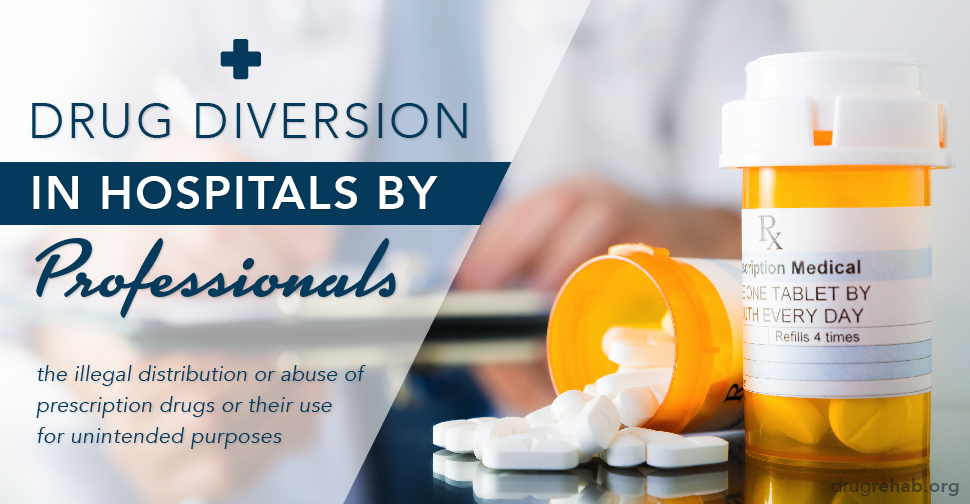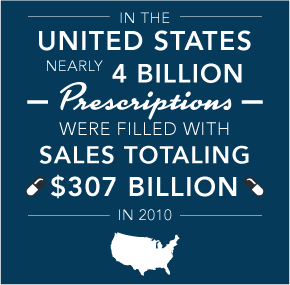
“Drug diversion is the illegal distribution or abuse of prescription drugs or their use for unintended purposes.” Sometimes diversion occurs in professional settings by the very people who are supposed to be helping others. With the millions of people suffering from addiction and the hundreds of thousands dying from it. Sometimes the medical professionals themselves are addicted to prescription drugs and might steal drugs or forge prescriptions—in these cases it’s important to remember that they too are human and addiction can happen to anybody.
 Most of us know what a crooked cop or a shady politician is, but wouldn’t know what they look like if they were standing right in front of us. These are professionals who have sworn an oath to do what’s right for the people; to serve and protect. Another type of professional who might surprise you is the dangerous doctor who prescribes drugs to people even when they don’t need them. Or worse, prescribing drugs to patients who really do need them, and then abusing that patient’s medicine—whether to get high or to sell them illegally. This act is also known as drug diversion.
Most of us know what a crooked cop or a shady politician is, but wouldn’t know what they look like if they were standing right in front of us. These are professionals who have sworn an oath to do what’s right for the people; to serve and protect. Another type of professional who might surprise you is the dangerous doctor who prescribes drugs to people even when they don’t need them. Or worse, prescribing drugs to patients who really do need them, and then abusing that patient’s medicine—whether to get high or to sell them illegally. This act is also known as drug diversion.
What Is Drug Diversion?
“Drug diversion is the illegal distribution or abuse of prescription drugs or their use for unintended purposes. The diversion of prescription drugs occurs at every point in the distribution chain” (Department of Health and Human Services). Drug diversions can have nasty consequences like loss of medical license, addiction, overdose, and death. Sometimes medical professionals become addicted to the very drugs they are prescribing, or hooked on the cash flow that comes from dealing opioid drugs like Oxycontin or Vicodin.
What Are The Most Commonly Abused Prescriptions?
Drug abuse and addiction doesn’t just imply that the drugs at hand are illegal like cocaine, heroin or meth. As soon as prescription drugs are used for anything other than their intended purpose, they become illegal. “The U.S. Drug Enforcement Administration on (DEA) recognizes ve classes of drugs that are frequently abused: anabolic steroids, depressants, hallucinogens, opioids, and stimulants” (Department of Health and Human Services).
What Are The Most Commonly Prescribed Drugs?
Remember that not all drugs are abused, but perhaps some of them are overprescribed. This could be due to a widespread epidemic of injury, or it could be due to addiction and drug seeking behavior. “In the United States in 2010, nearly 4 billion retail prescriptions were filled, with sales totaling $307 billion. The medication most often prescribed, 131.2 million times, was the opioid hydrocodone combined with acetaminophen. The opioid oxycodone combined with acetaminophen was prescribed 31.9 million times (National Center for Biotechnology Information).
Who Are Considered The Professionals?
Not all medical professionals knowingly take part in drug diversion. Because there is really no way to really test for pain levels, patients can sometimes have the upper hand when trying to score potent prescription drugs. Drug diversion can include everyone down the line from surgeons, physicians, their assistants, nurses, radiologists, dentists, psychiatrists, and so on. Physicians are trained to listen for keywords to spot a person shopping for drugs—but not all of them actually do it.
The Doctor’s On Prescription Drugs
There are also medical professionals who become addicted to the very drug they are supposed to be prescribing to help people—then they carry on with their daily work of saving lives and performing surgeries while high on drugs. Unfortunately, not all doctors abide by the hippocratic oath that they swear into, for which the first line is “physician, do no harm.” So yeah, there are those who suffer from addiction, and just because they practice medicine doesn’t give them some sort of immunity against drug addiction—they’re still human.
Hospital Drug Diversion Policies And Prevention
Hospitals view drug diversion just as seriously as the lawmakers who uphold punishment of the offenders. From an article by the Missouri Bureau of Narcotics and Dangerous Drugs (MBNDD), “hospitals should set a professional tone to deal sternly with any issues that place the hospital’s registrations at risk.” The article goes on to state that employees who knowingly hide information about drug diversion will be punished just as the primary culprit.

From the same source on drug diversion policies: “These are issues ranked by importance such as patient care, patient safety, hospital licensure, drug registrations, reputation, and media attention. All of these issues should be more important than one person who may have chosen to violate the laws and hospital policies and divert drugs from their legal channels” (MBNDD). So it’s not as if the hospital administrators don’t care, and there are rules, regulations and disciplinary actions in place to help govern drug diversion.
One Familiar Case Of Overprescribing Drugs
The famous Dr. William Hurwitz was sentenced to 25 years in prison for his over-prescription of opioid drugs; a practice that was likely responsible for at least 3 deaths and countless addictions. Doctor Hurwitz was made an example of, and during his sentencing in 2005, (documented in an article by John Tierney of the New York Times), Karen Tandy of the DEA held up a bag of 1,600 opioid pills and announced, “To the million doctors who legitimately prescribe narcotics to relieve patients’ pain and suffering… you have nothing to fear from Dr. Hurwitz’s prosecution.”
How Do These Systems Work?
“Such systems are multifaceted and require close cooperation between multiple stakeholders including, but not limited to, departments of pharmacy, safety and security, anesthesiology, nursing, legal counsel, and human resources” (NCBI). The problem’s that Doctor Hurwitz was a mere example; medical professionals still abuse prescription drugs and over-prescribe them. Hospitals and other medical branches do what they can to investigate drug diversion.
Drug Diversion Investigation Process—Why Don’t We Hear More?
As far as the legality of it, “diversion investigations involve, but are not limited to, physicians who sell prescriptions to drug dealers or abusers; pharmacists who falsify records and subsequently sell the drugs; employees who steal from inventory and falsify orders to cover illicit sales; prescription forgers; and individuals who commit armed robbery of pharmacies and drug distributors” (Drug Enforcement Administration).
Typically the public doesn’t hear much about drug diversion. Medical institutions make it a top priority to punish those involved in drug diversion cases—not only can they be punished, but in some cases, doctors will lose their license and even go to prison. A few of the reasons that a hospital might keep information from the public are:
- Fear of negative publicity
- Fear of State and Federal agency involvement
- Uncertainty about reporting requirements and avenues
- Justification that terminating the employee is enough
Drug Diversion Statistics Are Kept Secret
According to the National Council of State Boards of Nursing:
- Reliable statistics on the prevalence of drug diversion by nurses are not available
- By its nature, diversion is a clandestine (kept secret) activity, and methods in place in many institutions leave cases undiscovered or unreported
- Drug diversion by healthcare providers is universal among institutions in the United States
So What Exactly Is An Addiction?
 There are a lot of things people might expect from taking a prescription drug. From a medical standpoint, they expect that their pain, anxiety, depression, and other ailments will be cured. From a person seeking euphoria’s perspective, that they will catch a buzz. Neither of these types of individuals are likely to expect an addiction or some of the consequences of it.
There are a lot of things people might expect from taking a prescription drug. From a medical standpoint, they expect that their pain, anxiety, depression, and other ailments will be cured. From a person seeking euphoria’s perspective, that they will catch a buzz. Neither of these types of individuals are likely to expect an addiction or some of the consequences of it.
By definition, “addiction is defined as a chronic, relapsing brain disease that is characterized by compulsive drug seeking and use, despite harmful consequences. It is considered a brain disease because drugs change the brain; they change its structure and how it works. These brain changes can be long lasting and can lead to many harmful, often self-destructive, behaviors” (National Institute on Drug Abuse). In the grand scheme of things, it can be hard to see what addiction can do to you, even from a professional standpoint. Sometimes to get sober, it takes complete honesty, humility, and a willingness to listen—sometimes this might even mean seeking treatment.
How To Get Treatment For An Addiction
From 1999 to 2015 in the United States, 183,000 people died from opioid prescriptions (painkillers) and even though addiction is a serious illness, there is hope for recovery. If you are the one diverting drugs, you’re adding to the problem. If you know about a possible case of drug diversion, but aren’t telling anyone to cover for a friend or colleague—just remember that you’re not saving anybody’s life by keeping it a secret.
Doctors and patients alike can become addicted to drugs, and there is absolutely no shame in that. It’s better to seek help for a drug problem than to die of an overdose, or live a miserable life of addiction. If you’re a medical professional addicted to prescription drugs, or one of your patients might be suffering from an addiction. Even if you’re a person concerned about your well being and would like to know more about addiction treatment or drug diversion, contact us at 833-473-4227 today. Addiction doesn’t have to win—and you can fight it with treatment.
For More Information Related to “Drug Diversion in Hospitals by Professionals” Be Sure To Check Out These Additional Resources From DrugRehab.org:
- Ultram Abuse: Similar To Opiate Addiction
- Is Tramadol An Opioid Analgesic?
- Heroin and Opioid Addiction Statistics
- Environmental Risk Factors for Developing an Addiction
- The Benefits of Faith-Based Recovery Programs
Sources
Center for Disease Control and Prevention – Prescription Opioid Overdose Data
National Center for Biotechnology Information – Diversion of Drugs Within Health Care Facilities, a Multiple-Victim Crime: Patterns of Diversion, Scope, Consequences, Detection, and Prevention
National Council of State Boards of Nursing – Institutional Diversion Prevention, Detection and Response
National Institute on Drug Abuse – The Science of Drug Abuse and Addiction: The Basics


